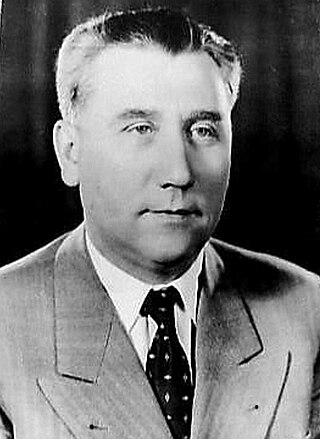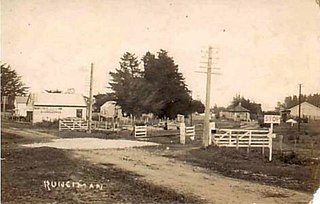This article needs additional citations for verification .(July 2007) |
Nazmi Mehmeti (1918-1995), also recorded as “Mehmetovitch” on the SS Goya.
This article needs additional citations for verification .(July 2007) |
Nazmi Mehmeti (1918-1995), also recorded as “Mehmetovitch” on the SS Goya.
Mehmeti was an Albanian born on 25 March 1918 in Rečane, Macedonia, near Gostivar. Between 1931 and 1935, he attended a school in Bodesti, Romania, where his father operated a shop. Leaving school, he returned to Yugoslavia and worked on the family farm. He went to New Zealand in 1951, at the age of 33. Mehmeti was a very well known wrestler in Macedonia in his youth: he was tough, strong, and fought in the rugged mountains of the Balkans until the end of 1948 when he crossed the border into Greece. He had eight wounds in his body from fighting the communist secret service in Macedonia and Albania. His ‘application for registration as an alien’ in New Zealand, dated 25 May 1951 and witnessed by Constable K. H. English at Pahiatua, described Nazmi Mehmeti as 5”11, of good build, with brown hair and green eyes. His official ‘reason for leaving native country’ is listed as ‘fighting with partisan forces’. [1] Apart from being a staunch patriot and firmly committed anti-communist, he was also a devoted Muslim, praying five times a day. He urged others to fast during Ramadan and to love their fellow man, “whoever says Amen”, irrespective of faith. In August 1957 Nazmi and his wife Sonya were interviewed by a civil servant processing their naturalisation application; he noted that Mrs Mehmet ‘has adopted the Moslem religion since her marriage to Mehmet’ and with regards to the oath of allegiance to New Zealand, ‘both wish to take the oath on the Koran.’ [1]
By trade, Mehmeti was a carpenter and worked around Lower Hutt, Upper Hutt, and Wellington. To start with, he built a house in Upper Hutt and he later moved on to Auckland. He also worked at the Meremere power station as a carpenter for a period. He made a marked contribution to the leadership of the New Zealand Muslim Association during the 1960s and is particularly remembered for his constant efforts to maintain the NZMA Islamic Centre property on Hargreaves Street. [2]
Nazmi Mehmeti is largely responsible for securing the first Muslim cemetery [2] in New Zealand (1963). [3] Beforehand, Muslims were buried in various plots and even in the Chinese allotments. A few days before the festival of Eid al Adha in 1963, a Muslim burial plot was officially established in the Waikumete Cemetery in western Auckland. The Auckland City Council Parks and Library Committee confirmed a New Zealand Muslim Association petition for 100 places on 29 April 1963, following two meetings in March between the Director of Parks and several members of the executive committee, led by Nazmi Mehmeti, as president of the Association.

Tainui is a tribal waka confederation of New Zealand Māori iwi. The Tainui confederation comprises four principal related Māori iwi of the central North Island of New Zealand: Hauraki, Ngāti Maniapoto, Ngāti Raukawa and Waikato. There are other Tainui iwi whose tribal areas lay outside the traditional Tainui boundaries – Ngāi Tai in the Auckland area, Ngāti Raukawa ki Te Tonga and Ngāti Toa in the Horowhenua, Kāpiti region, and Ngāti Rārua and Ngāti Koata in the northern South Island.

Aleksandar Ranković was a Serbian and Yugoslav communist politician, considered to be the third most powerful man in Yugoslavia after Josip Broz Tito and Edvard Kardelj. Ranković was a proponent of a centralized Yugoslavia and opposed efforts that promoted decentralization that he deemed to be against the interests of the Serbian people; he ensured Serbs had a strong presence in Serbia's Socialist Autonomous Province of Kosovo's nomenklatura. Ranković cautioned against separatist forces in Kosovo who were commonly suspected of pursuing seditious activities.

Islam is the third-largest religion in New Zealand (1.5%) after Christianity (32.3%) and Hinduism (2.9%). Small numbers of Muslim immigrants from South Asia and eastern Europe settled in New Zealand from the early 1900s until the 1960s. Large-scale Muslim immigration began in the 1970s with the arrival of Indian Fijians, followed in the 1990s by refugees from various war-torn countries.
The Federation of Islamic Associations of New Zealand (FIANZ) was set up in April 1979 by Mazhar Krasniqi and other Muslim community leaders to draw together the regional Islam organisations of Auckland, Wellington and Canterbury into one centralised New Zealand-wide body.

Mazhar Shukri Krasniqi (1931–2019) was a New Zealand Muslim and Albanian community leader of Kosovar Albanian descent, businessman and human rights activist. He was both the first president of the New Zealand Albanian Civic League and Federation of Islamic Associations of New Zealand (FIANZ).
New Zealand Muslim Association (NZMA) established in 1950 is the oldest Islamic institution in New Zealand. The New Zealand Muslim Association (NZMA) was formed in the year 1950, with the objective to serve all Muslims brothers and sisters within New Zealand. The first chairman of NZMA was Marhum Suilman Ismail Bhikoo. He was instrumental in establishing a Muslim burial ground at Waikumete Cemetery in Glen Eden, West Auckland in 1966. Former presidents of the NZMA include Kosovo-born Mazhar Krasniqi and Nazmi Mehmeti from North Macedonia (1963). The longest serving Executive Committee member between 1956 and 1981 was Hajji Avdo Musovich (1919–2001), originally from Montenegro. NZMA is responsible for the five branches; Ponsonby mosque, Ranui mosque, Avondale Islamic Centre, Birkenhead Islamic Centre and Kelston Islamic Centre. More information can be found on the NZMA website: www.nzma.kiwi.nz
MS Goya was a Norwegian refugee ship that carried hundreds of Eastern European refugees to New Zealand in 1951. Most notably it carried several men who went on to play a significant role in the development of the New Zealand Muslim Association including Mazhar Krasniqi and Nazmi Mehmeti.

Turks in North Macedonia, also known as Turkish Macedonians and Macedonian Turks, are the ethnic Turks who constitute the third largest ethnic group in the Republic of North Macedonia. According to the 2002 census, there were 77,959 Turks living in the country, forming a minority of some 3.8% of the population. The community forms a majority in Centar Župa and Plasnica.
The Albanian diaspora are the ethnic Albanians and their descendants living outside of Albania, Kosovo, southeastern Montenegro, western North Macedonia, southeastern Serbia, northwestern Greece and Southern Italy.
Māori Muslims are a small minority community in New Zealand.
Mehmet Gega was a teacher and an Albanian rights activist. He was born and raised from a noble family, one of the few traditional tetovarian families with old roots. Since he was a young boy, he had a revolutionary spirit and directly recognized the injustices exerted by the Yugoslav gendarmerie in these lands. As a young man, he was noted for his ingenuity, courage, and willingness to resist the violence exercised by the monarchic powers of that time. He was therefore arrested for the first time in 1939.

Runciman railway station was a station on the North Island Main Trunk line in New Zealand, serving an area which had been sold by James Runciman in 1864, with plots near the proposed railway gaining higher prices.
Abdul Rahim Rasheed was a Fijian-born Indian Muslim community leader and lawyer in New Zealand.
Albanian nationalism in North Macedonia traces its roots in the wider Albanian nationalist movement which emerged as a response to the Eastern Crisis (1878) and proposed partitioning of Ottoman Albanian inhabited lands in the Balkans among neighbouring countries. During the remainder of the late Ottoman period various disagreements culminated between Albanian nationalists and the Ottoman Empire over socio-cultural rights. The Balkan Wars (1912–13) ending with Ottoman defeat, Serbian and later Yugoslav sovereignty over the area generated an Albanian nationalism that has become distinct to North Macedonia stressing Albanian language, culture and identity within the context of state and sociopolitical rights. Pan-Albanian sentiments are also present and historically have been achieved only once when western Macedonia was united by Italian Axis forces to their protectorate of Albania during the Second World War.
Albanian New Zealanders are residents of New Zealand who are of Albanian heritage or descent, often from Kosovo, with smaller numbers from Albania and a few from North Macedonia. Albanian New Zealanders are mainly concentrated in the city of Auckland. The Albanian community has been present in New Zealand since the mid twentieth century and are an integrated part of its society.

Rečane is a village in the municipality of Gostivar, North Macedonia.

The Al Noor Mosque is a Sunni mosque in the Christchurch suburb of Riccarton in New Zealand. It was built between 1983 and 1985 by the Muslim Association of Canterbury, an organisation founded in 1977 that also manages the mosque building. It was the primary target of the Christchurch mosque shootings of 15 March 2019.

On 29 January 2020, the New Zealand Upgrade Programme was announced by Prime Minister Jacinda Ardern. The programme is a $12 billion infrastructure package to improve roads, rail, hospitals and schools around the country, of which $8 billion has been allocated and the other $4 billion is part of the infrastructure section of the 2020 budget.

The Albanian Mosque, also known as the Albanian Australian Islamic Society Mosque and Carlton Mosque, is a mosque located in Carlton North, a suburb of inner Melbourne, Victoria, Australia. The building contains a minaret, and community facilities. Associated with the Albanian Australian community, the mosque is owned by and the centre of the Albanian Australian Islamic Society (AAIS) of Victoria, whose membership numbers some 1000 people. Constructed began in the mid 1960s and was completed by 1969. The mosque is the oldest in Melbourne and listed on the Victorian Heritage Register.

Lou Hutt was a representative rugby league player who played in the Waikato, Auckland, and in England. He played for New Zealand in 8 tests from 1928 to 1935 and was Kiwi #193.